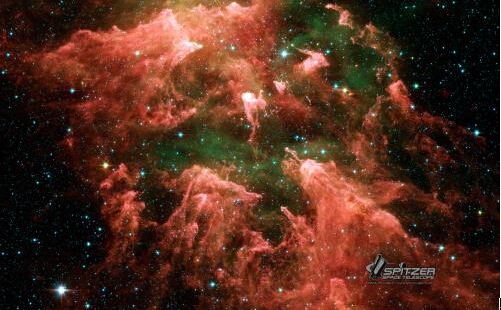http://www.sciencehuman.com 科学人 网站 2015-04-17

中国科技网4月10日报道(张微 编译)2015年4月11日-14日在马里兰州巴尔的摩举行的美国物理学会四月会议期间,来自费米实验室的Eun Joo Ahn将展示一组有关宇宙射线组成的大规模研究的数据,这项研究是在阿根廷彼埃尔奥格天文台进行的长达八年的研究项目。他们的研究结果表明宇宙射线比之前预想的要复杂。不仅仅是由轻粒子(如质子)或重粒子(如铁)组成,数据表明,中量级粒子如氦和氮才是宇宙射线的重要组成部分。
高能宇宙射线包含的能量是地球上最强的粒子加速器产生粒子能量的上百万倍。当宇宙射线撞击大气中的分子时,碰撞的能量激起了粒子瀑布雨向地球坠落。科学家们通过研究粒子雨来了解触发他们的高能宇宙射线。
Ahn和她的同事通过调查它们穿透大气层的距离,来测量宇宙射线空气簇射粒子的规模。收集这些数据是一个很大的挑战,因为随着粒子能量越高,粒子数量就越少。举个例子,在1015eV能量上,每年每平方米仅有一个粒子到达。在1020eV能量上,数据急剧下降到每100年每平方公里有一个粒子到达。因此只有大型天文台才能发现这些稀缺粒子,并利用它们重建射线穿过大气层的路径。
安装在彼埃尔奥格天文台——世界上最大的宇宙射线天文台的混合探测器,使这方面的研究成为可能。
地面探测器,1600个大容器每个盛入3000加仑的水,占据了彼埃尔奥格天文台3000平方公里的面积,测量落向地球的粒子发出的射线。由于高能宇宙射线粒子在水中比光运行的速度快,所以当它们穿过水箱时发出了可检测辐射的短脉冲。
荧光望远镜——彼埃尔奥格天文台第二种类型探测器,是地面探测器的一个补充。空气簇射粒子穿过大气层激发氮分子产生荧光。彼埃尔奥格天文台的望远镜能够监测到这种微弱的光线,光线的变化取决于粒子的大小。
荧光望远镜可以收集到非常精确的数据,但是它们只能在黑暗的时候使用,大约13%的时间。地面探测器提供的组成成分数据不那么准确,但是它们能24小时不间断运行,因此对于数据库具有统计功效。
“如果我们只有荧光望远镜获取的数据,我们就没法进行统计分析。也就很难获得一个准确的重建轨迹。如果只有地面探测器,我们就不能对组成成分做出准确判断,” Ahn说。“如果粒子雨通过这两种方式监测,那么我们就能精确地重建宇宙射线穿透大气层的路径。
Ahn和她的团队利用计算机模拟来测试与它们的大型数据库相匹配的不同模型。“有许多可行的,令人信服的模型能够解释宇宙射线的光谱形态,” Ahn说。不过挑选出其中一个模型进行研究还为时尚早。“了解组成成分是理解宇宙射线光谱形态的关键因素,”Ahn说。“这是通往未来研究的必经之路。”
New data shows cosmic rays are more complex than expected
During the American Physical Society's 2015 April Meeting, to be held April 11-14 in Baltimore, Maryland, Eun Joo Ahn from Fermilab will present data from the most extensive study yet on the composition of cosmic rays—an 8-year-long project carried out at the Argentina-based Pierre Auger Observatory. Their results show that cosmic rays are more complex than previously thought: instead of being made up solely of very light particles (like protons) or very heavy ones (like iron), the data suggest that midweight particles like helium and nitrogen are significant components of cosmic rays.
High energy cosmic rays contain millions of times more energy than even particles the most powerful particle accelerators on Earth can produce. When a cosmic ray hits a molecule in the atmosphere, the energy of the collision sparks a cascading shower of particles falling to earth. Researchers can study these particle showers to learn about the high energy cosmic rays that triggered them.
Ahn and her colleagues measured the mass of cosmic ray air shower particles by examining how far into the atmosphere they penetrated. Such data can be challenging to gather because the particles become increasingly scarce as they become more energetic. For instance, at 1015eV, one might expect just one particle per square meter per year. At 1020eV, this drops precipitously to one particle per square kilometer per century. Observatories must therefore be very large in order to detect these scarce particles and use them to reconstruct the ray's path through the atmosphere.
The hybrid detector setup at Pierre Auger, the world's largest cosmic ray observatory, makes this type of analysis possible.
Ground detectors, 1600 tanks containing 3000-gallons of water each spaced evenly over Auger's 3000 square kilometer area, measure the radiation emitted by particles that fall to the earth. Because high-energy cosmic ray particles travel faster than the speed of light in water, they emit short bursts of detectable radiation when passing through the water tanks.
Fluorescence telescopes—the second type of detector at Auger—complement the ground detectors. Air shower particles passing through the atmosphere excite nitrogen molecules, causing them to fluoresce. Auger's telescopes can detect this faint glow, which varies depending on the particle's size.
The fluorescence telescopes can collect very precise measurements, but they are only useful when it's dark—about 13% of the time. The ground detectors provide less precise compositional data, but they run around the clock and so bring more statistical power to the data set.
"If we only have the fluorescence telescopes, we're limited by statistics. It's a bit more difficult to get an accurate reconstruction of the trajectory. If it's only the surface detectors, we don't have a very good handle on the composition," said Ahn. "If the shower is detected by both types, then we can do a very precise reconstruction" of its path through the atmosphere.
Ahn and her team used computer simulations to test how various models fit with their large data set. "There are many viable, convincing models that explain the shape of the cosmic ray spectrum," said Ahn. It's too soon to identify one particular model as a frontrunner. "Knowing the composition is key to understanding the shape of the cosmic ray spectrum" said Ahn. "It's a gateway to answering bigger questions."
[中科网]